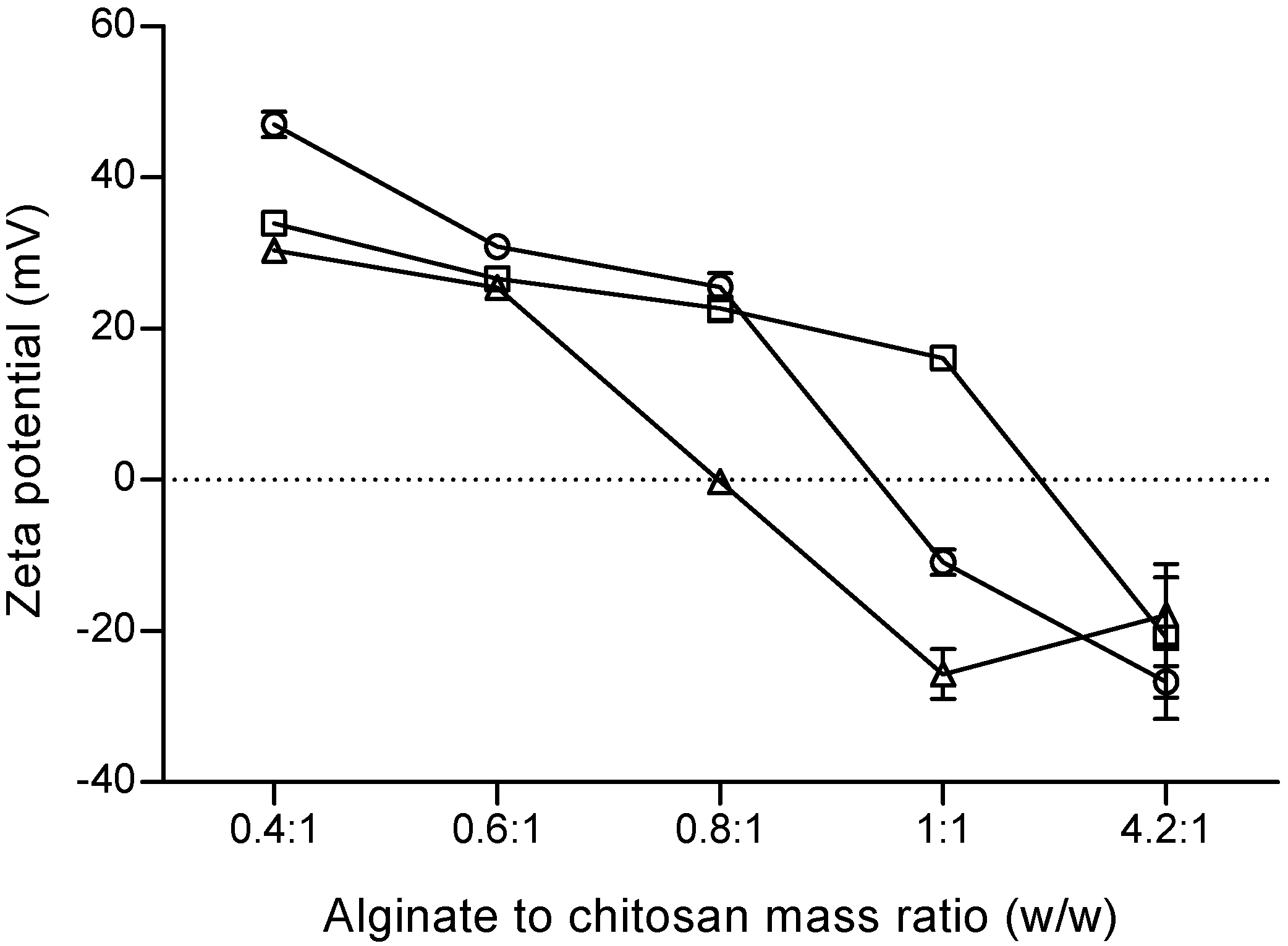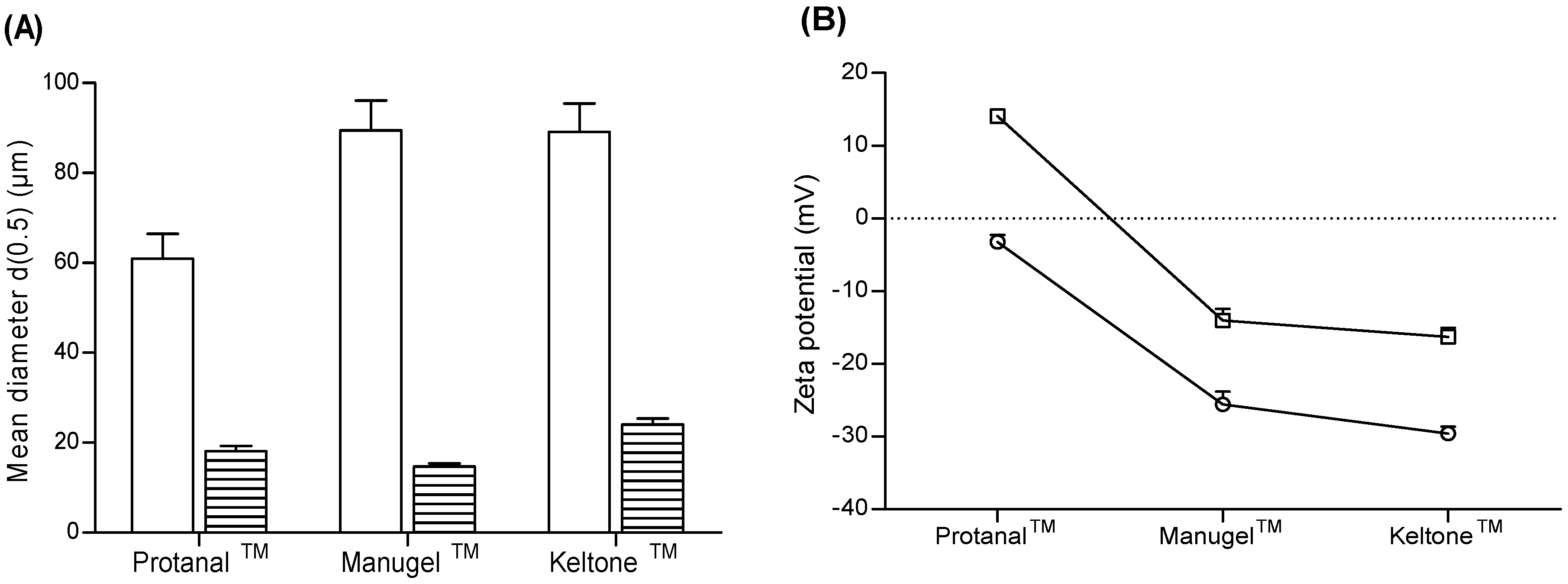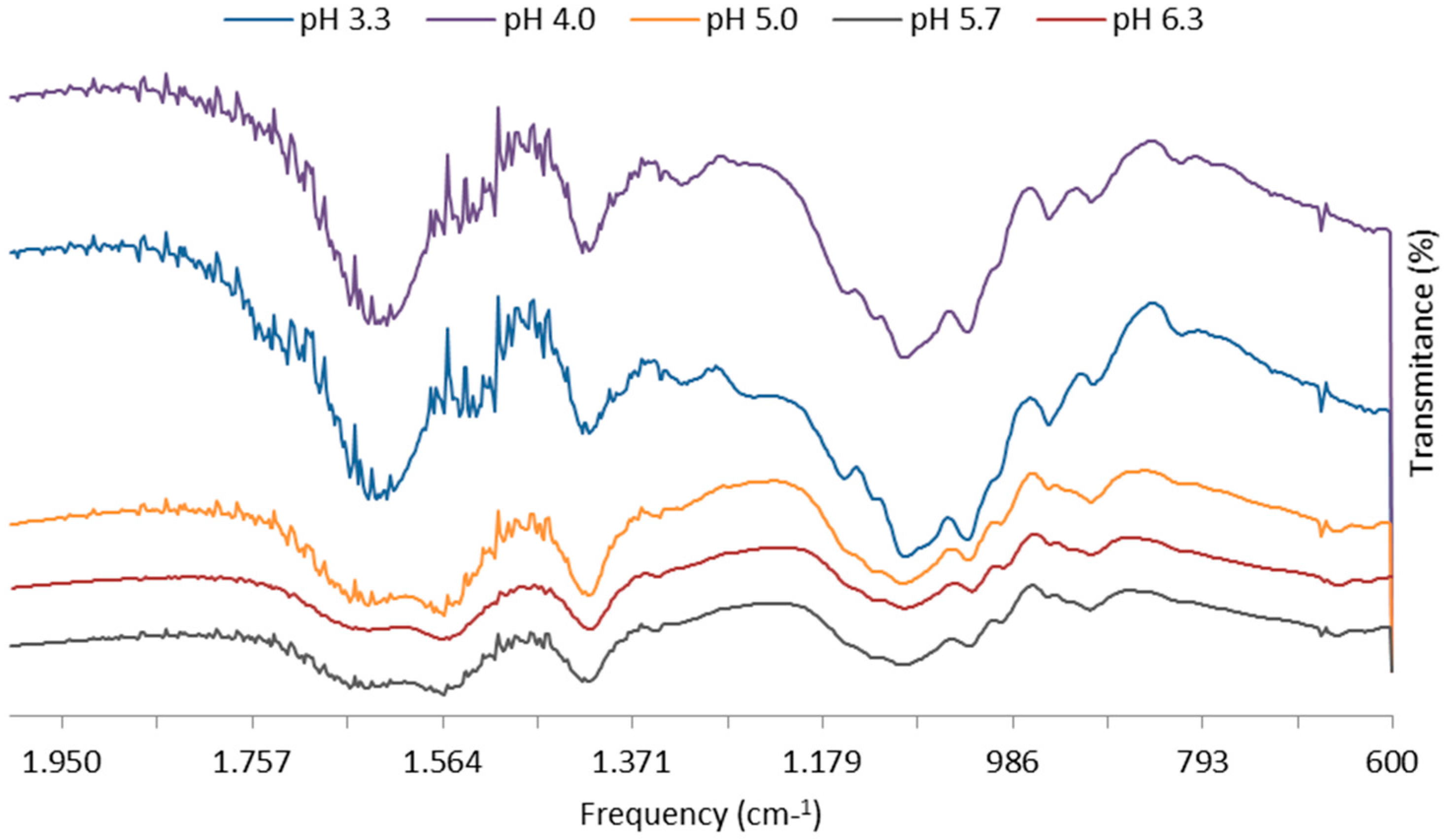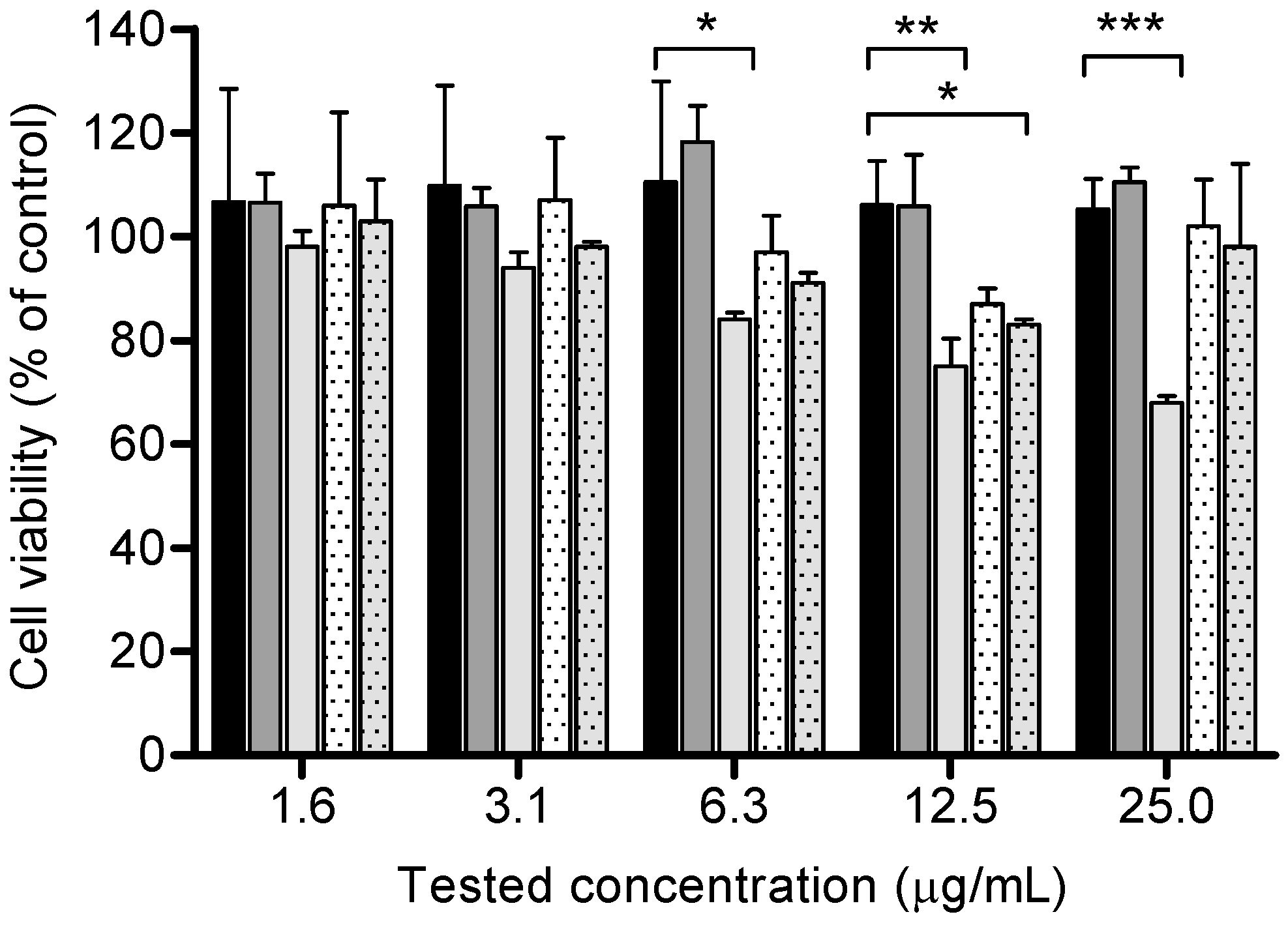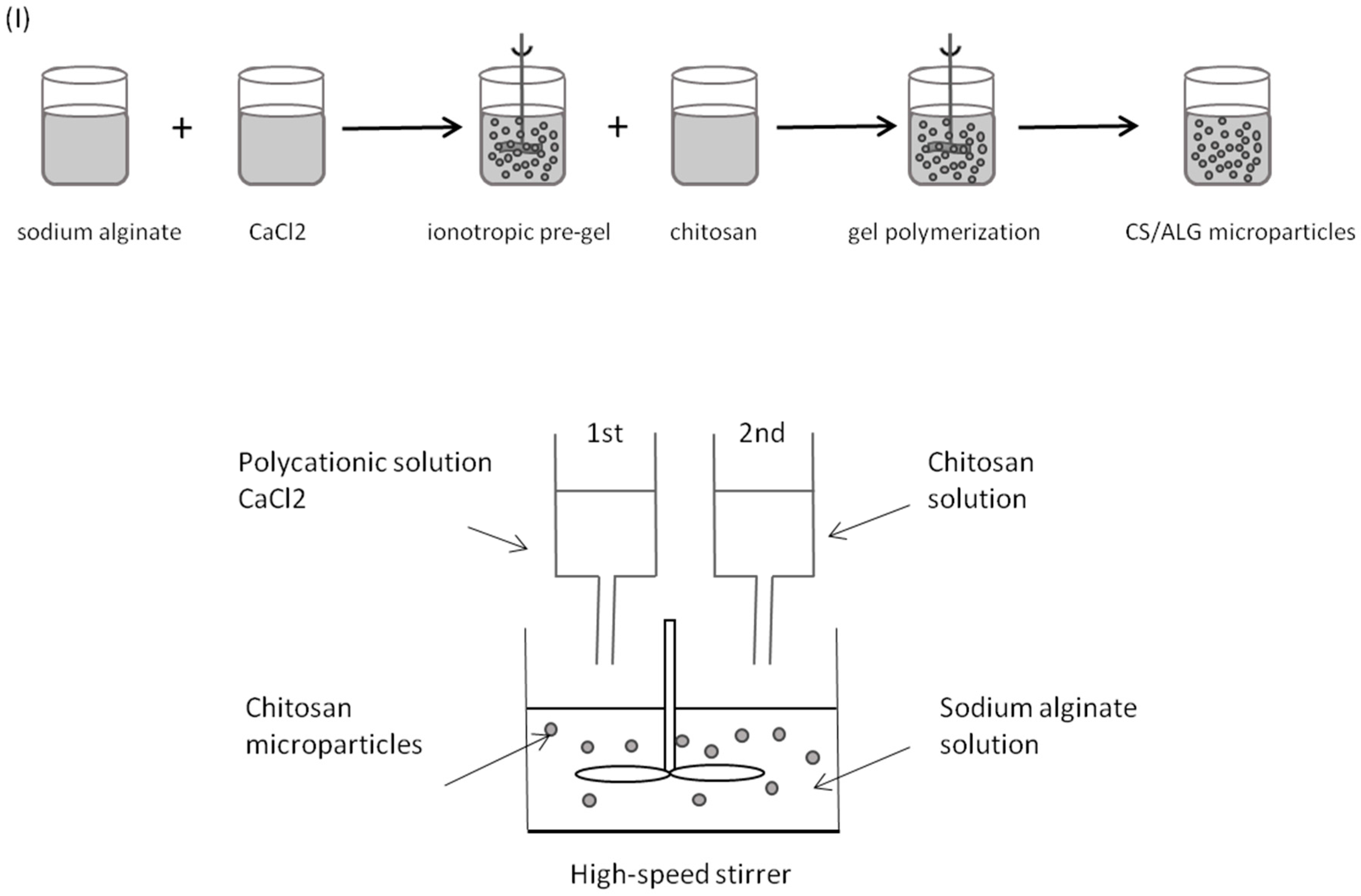1. Introduction
Enhanced immunization strategies must be urgently found for tuberculosis control [
1,
2]. The current available vaccine used for pre-exposure vaccination against tuberculosis is
Mycobacterium bovis BCG. As with most vaccines nowadays, BCG is parenterally administrated by subcutaneous route. This implies a relatively high production cost, the need for cold chain, and the need for trained personnel for vaccine administration, while it also leads to lower patient compliance. Regarding the resulting immune response, parenterally delivered vaccines usually produce poor mucosal responses, which is critical to preventing tuberculosis, as
Mycobacterium tuberculosis normally enters the host through mucosal surfaces. The nasal route might therefore be an attractive alternative administration route [
3].
Regarding tuberculosis, it is essential for a new vaccine to better target the lungs while improving interaction with antigen presenting cells (APCs) in the lung mucosa, such as alveolar macrophages [
4]. It is also well known that the eradication of
Mycobacterium tuberculosis with pre-exposure vaccination depends on adequate antigen presentation to amplify the elicited immune response, essentially cellular Th1 types [
5,
6,
7,
8]. As such, whole live attenuated bacteria act as the ideal antigen producers and vectors, as they are multigenic and normally mimic pathogens and surpass natural barriers.
In recent decades, several studies have elucidated the pros and cons of the nasal route for vaccine administration. It is well known that, for soluble antigens, limited absorption occurs at the nasal mucosa due to physiological barriers (
i.e., mucosal epithelium, rapid mucociliary clearance, protease degradation) [
9]. Many strategies have been proposed in order to surpass these barriers and to increase the immunogenicity of intranasal delivered antigens, namely, the use of permeation enhancers, mucosal adjuvants and nano- and microparticulate delivery systems [
10,
11]. Some studies refer to a boost in the immune response due to an adjuvant effect of particulate delivery systems, combined with the use of potent immunopotentiators, either present in the formulation or co-delivered with antigens [
12,
13,
14,
15,
16,
17,
18].
Taking into consideration the aforementioned, it has been hypothesized that BCG bacilli modification through encapsulation in polymeric microparticulate delivery systems could be an alternative to the classical BCG vaccine, suitable for mucosal immunization. Thus, the main goal of this work was to encapsulate whole live BCG into polymers with biocompatible and mucoadhesive properties using only mild conditions, so that BCG viability was maintained and the biocompatibility of the developed microparticulate delivery system was assured. Microencapsulation of BCG in chitosan-alginate microparticles will allow the following to take place
in vivo, in sequence: bacilli desorption from the particle surface; degradation and erosion of the polymer network; release of bacteria. Moreover, with the entrapment of BCG in polymeric microparticles, it is expected to change the BCG recognition pattern by the immune system and to modulate the mechanism of cellular uptake by APCs cells. The selection of the microsize range was related to the intrinsic length of BCG bacilli rod of approximately 2–4 micrometers, whereas the preference for electropositively charged microparticles depends on their ability to better interact with negatively charged mucin [
19,
20,
21].
The use of biodegradable polymeric particles has been proposed as a promising approach to elicit adequate immune responses, while protecting antigens from degradation [
18]. The preparation of polymeric particles can be achieved through a wide range of preparation methods, each one yielding particle formation within a determined size range. For instance, nanoprecipitation and supercritical fluid technology usually yield nanoparticles, whereas spray-drying and solvent evaporation may produce nano- or microparticles depending on the experimental conditions [
22,
23]. It is generally stated that, for nasal delivery of antigens, nanoparticles are more favorable than particles in the microsize range, as nanoparticles are better taken up by the M-cells present in the nasal associated lymphoid tissue (NALT), and better transported through the epithelial cells (by paracellular and transcellular transference), thus, leading to increased local and systemic immune responses [
24,
25]. Nevertheless, microparticles sized up to 40 micron have also been described as successful in eliciting immune responses through nasal administration [
11,
26,
27,
28,
29].
The most commonly described biodegradable polymers are poly(d,l-lactide-co-glycolide) (PLGA) and poly(l-lactide) (PLA); however, particle formation with PLGA and PLA occurs only in the presence of organic solvents. This is a major drawback, for several reasons. Not only the use of organic solvents may lead to relevant toxicological effects, it can also prompt antigen denaturation or hamper cellular vaccine viability, while formulation methods usually require multiple steps and are time consuming. In view of the aim of producing a live vaccine, the longer it takes to carry out the formulation steps, the greater the possibility of losing some of the vaccine or of compromising cell viability, thereby reducing the encapsulation efficiency and potency of the vaccine.
In this context, chitosan (a deacetylated form of chitin extracted from crustaceans), and sodium alginate (a natural product extracted from algae belonging to the Phaeophyceae, mainly species of
Laminaria) were chosen to prepare polymeric microparticles by ionic cross-linking methods as described elsewhere [
30,
31,
32,
33,
34,
35]. Both chitosan and alginate have been extensively studied as biomaterials and pharmaceutical excipients due to their biodegradability and low toxicity, and have been included in the composition of several foods and dietary supplements [
36,
37]. With ionic gelation methods, particles are formed in a single step by a simple mechanism, usually involving two different polymers and one complexation agent, by adding one polymer solution to the other one with stirring. Most commonly described complexation agents used with chitosan and alginate are calcium chloride and tripolyphosphate (TPP) [
35,
38].
The widespread use of polyionic complexation methods presents many advantages, such as their simplicity, versatility and flexibility, being applicable for virtually all polymers which can be polymerized in the presence of a complexation agent, while being easily adjusted by changing a number of experimental parameters. During optimization studies, the formulation conditions can be changed to obtain desired features, namely, particle size, encapsulation efficiency, surface charge, biocompatibility profile, and production yield. The type of used polymers (i.e., chemical nature, molecular weight, viscosity, purity, pH, and other relevant specifications), the polymer to polymer mass ratio, the type and concentration of complexation agent, the homogenization type (i.e., shear, speed and duration) and the polymer to antigen ratio are some of the variables which significantly influence the particles’ characteristics. Furthermore, the mild preparation conditions of these methods allow the encapsulation of antigens without degradation caused by high temperatures, oxidation or hydrolysis, as with other commonly used techniques.
As previously stated, both chitosan and alginate have been extensively used in the preparation of polymeric nano- and micro-particles for immunization purposes. Chitosan and its derivatives are described to increase the absorption of macromolecules through epithelial membranes, and to increase both antigen residence time and uptake at the mucosal site, due to its intrinsic mucoadhesiveness [
11,
39,
40,
41,
42,
43,
44]. Chitosan has been used to prepare nano- and microparticles intended for nasal and oral delivery of vaccines with great results, as chitosan particles were able to elicit strong systemic and local immune responses to different antigens [
16,
24,
25,
34,
41,
45,
46,
47,
48,
49,
50,
51,
52,
53].
Alginates are block copolymers polysaccharides, composed of long homopolymeric regions of mannuronate (M) and guluronate (G), as the result of the conversion of mannuronic and guluronic acid through neutralization during extraction from its natural source. The proportion, distribution and length of these blocks determine the chemical and physical properties of the alginate molecules. While G-blocks provide gel-forming capacity, MM and MG units provide flexibility to the uronic acid chains, with flexibility increasing in the order GG < MM < MG.
Alginates constitute a very versatile material, having numerous pharmaceutical applications due to their gelling, film-forming, thickening and stabilizing properties. It is said that the improved stability of chitosan formulations can be assessed by developing chitosan blends with another polymer, namely sodium alginate [
36]. Two other valuable properties of alginates are that they are water-soluble, allowing gel formation without heating or cooling, and also that the alginate matrix allows the entrapment of molecules by capillary forces, which remain free to migrate by diffusion, depending on the size. These features make alginates attractive gelling biopolymers for cell encapsulation purposes. Gel formation and gel structure are determined by alginate type and calcium salt (Ca
2+), being influenced by pH value, solubility and temperature. For instance, at lower pH values, alginate gel is shrunk and a reduction of the pore size of alginate matrix can be achieved, especially in the case of low G content alginate. As such, these components and factors must be matched in order to optimise the overall formulation of alginate microparticles by ionotropic gelation.
The formulation studies presented in this work aimed the optimization of the preparation conditions of BCG-loaded polymeric particles taking into consideration the final yield of production, encapsulation efficiency, particle size distribution and surface charge. Therefore, variables such as the type of polymer or of polymer blends, polymers solution pH value, the polymer/polymer and BCG/polymers ratio, as well as the type and time of homogenization procedures and order of polymers and counter ions solutions’ incorporation were studied. The herein described effects of experimental conditions on critical features of microparticle formulations provide a processing window for manipulating and optimizing particles in the microsize range for intended applications.
The expected advantages of the herein described systems for vaccine delivery include the capacity of polymeric microparticulate systems to increase antigen residence time (due to the differentiated release profile in the presence of alginate and chitosan) and to enhance antigen interaction with the cell surfaces. Moreover, due to chitosan’s and alginate’s mucoadhesiveness, microparticles would be able to promote mucopenetration, thus increasing antigen delivery.
3. Materials and Methods
3.1. Materials
Sodium alginate polymers of high viscosity (14,000 mPa.s, 20 mg/mL), medium viscosity (3000 mPa.s, 20 mg/mL; M/G ratio of 1.56), and low viscosity (187 mPa.s, 20 mg/mL) (27 mPa.s, 10 mg/mL; M/G ratio of 1.56) were purchased from Sigma-Aldrich (Dorset, UK) (structural viscosity as provided by suppliers). Other tested sodium alginates include: low G-content (40%) Keltone LVCR (218 mPa.s, 20 mg/mL), high G-content (63%) Manugel LBA (773 mPa.s, 100 mg/mL), and high G-content (65%–75%) Protanal LF 10/60 (20–70 mPa.s, 10 mg/mL), which were a gift from FMC BioPolymer A.S. (Sandvika, Norway). Sodium tripolyphosphate (TPP) and calcium chloride (CaCl2) were purchased from Sigma-Aldrich (Dorset, UK). Alginate stock solutions were prepared in ultra-purified water.
Most experiments were performed using solutions containing chitosan of low-molecular weight (<150 kDa) and deacetylation degree of 92%; chitosan of medium molecular weight (<450 kDa) and deacetylation degree of 85%; and chitosan of high molecular weight (≈600 kDa) or high structural viscosity (748 mPas, 1% in acetic acid 1%, 20 °C) and undefined deacetylation degree, all purchased from Sigma–Aldrich (Dorset, UK) (specifications as provided by suppliers). The molecular weights were not verified. Chitosan stock solutions were prepared in 1% acetic acid solution in ultra-purified water.
The BCG strains—
M. bovis BCG Pasteur strain 1173 (ATCC 35734™) (American Type Culture Collection (ATCC) Manassas, VA, USA)and a recombinant
M. bovis BCG harboring a pMN437 plasmid for expression of Green Fluorescent Protein (rBCG-GFP) [
76], were kindly supplied by Prof Elsa Anes (FFUL). The bacterial cell culture reagents were purchased from Difco, Franklin Lakes, New Jersey, USA. Both
M. bovis BCG Pasteur and rBCG-GFP cultures were grown on Middlebrook’s 7H9 broth Medium supplemented with 5% (
v/
v) OADC (oleic acid, albumin, dextrose and catalase supplement) at 37 °C/5% CO
2.
The THP1 cells (ATCC TIB-202™) a human monocyte cell line was obtained from (ATCC, USA). All animal cell culture reagents were purchased from Invitrogen (Paisley, UK). Phorbol myristate acetate (PMA), 3-(4,5-dimethyl-2-thiazolyl)-2,5-diphenyl-2H-tetrazolium bromide (MTT), dimethylsulfoxide (DMSO) were all from Sigma-Aldrich (Dorset, UK).
3.2. Preparation of Polymeric Microparticles
Polymeric microparticles were initially prepared using modifications of previously described ionic cross-linking methods [
30,
31,
32,
33,
34], by high speed stirring at room temperature and without organic solvents—Methods (I) and (II). Alginate and chitosan were dissolved in ultra-purified water.
In Method (I), polymeric microparticles were prepared via formation of an alginate ionotropic pre-gel, by allowing sodium alginate solution to react with calcium chloride prior to chitosan addition. (
Figure 9). Briefly, a 7.5 mL aliquot of 18 mM calcium chloride solution was added drop wise into a beaker containing 117.5 mL of a 0.6 mg/mL sodium alginate solution, and stirred for 60 min under 600 rpm, to provide an alginate pre-gel. Then, 25.0 mL of a 0.7 mg/mL chitosan solution was added drop wise into the pre-gel and stirred over 90 min, giving a final alginate and chitosan concentration of 0.5 mg/mL and 0.1 mg/mL, respectively (alginate: chitosan mass ratio 4.23:1). A colloidal dispersion formed upon polycationic chitosan addition.
In formulation Method (II), polymeric microparticles were prepared by allowing chitosan and sodium alginate to polymerize, by means of ionic interaction between positively charged amine groups of chitosan and negatively charged carboxyl groups of alginate, prior to TPP addition (
Figure 10). Briefly, a 5.0 mL aliquot of 1.0 mg/mL chitosan were added drop wise into a beaker containing volume ranging from 0.1 to 5.0 mL of 1.0 mg/mL of sodium alginate solution, followed by dropwise addition of 1.0 mL of 1.0 mg/mL TPP under high-speed stirring at 600 rpm for 120–150 min. Alginate: chitosan ratios ranged from 0.02:1 to 1:1 (
w:
w).
Preliminary experiments with three replicates were designed in order to investigate the appropriate concentration range for chitosan, alginate and sodium tripolyphosphate, according to a previously described method [
32] with modifications (
Table 8). The purpose was to identify the impact of the key components of the polyelectrolyte matrix, such as different pH values and polymers mass ratio, on parameters such as particle size and zeta potential. Therefore, high, medium and low molecular weight chitosan, and TPP, were used and their volume was kept constant (5.0 mL and 2.0 mL, respectively), while high, medium and low viscosity alginate was used in increasing volumes.
High shear homogenization (ultra-turrax T10basic at 11,400 rpm, IKA-Labortechnik, Staufen, Germany) and sonication (Branson Sonifier 250, equipped with a 3 mm microtip probe, BRANSON Ultrasonics Corporation, Danbury, CT, USA) were assessed as potential alternatives to high speed stirring to prepare microparticles. The techniques were evaluated considering physical stability of microparticle suspensions (general aspect, formation of aggregates) and microparticles characteristics, such as size distribution and surface charge. Microparticle preparation was in accordance with above described formulation Method (I) and Method (II), with modifications. Briefly, in accordance with previously described formulation Method (I), 0.75 mL of 18 mM calcium chloride were added to 11.75 mL of 0.6 mg/mL sodium alginate, and either homogenized for 3 min in ultra-turrax or sonicated for 3 min at 20% output intensity, prior to 2.5 mL of 0.7 mg/mL chitosan addition, and subsequent homogenization or sonication as described. As for Method (II), 5.0 mL of 1.0 mg/mL chitosan were added to 0.1–5.0 mL of 1.0 mg/mL of sodium alginate, followed by addition of 1 mL of 2.0 mg/mL TPP, and either homogenized for 3 min in ultra-turrax or sonicated for 3 min at 20% output intensity.
The results obtained during formulation optimization studies led us towards the rejection of Method (I) and the development of a different preparation method—Method (III). In Method (III), polymeric microparticles were prepared by inducing the pre-gelation of chitosan with TPP, followed by alginate coating (
Figure 11). Briefly, alginate and chitosan were dissolved in ultra-purified water. Microparticles were formed by the dropwise addition of a 1.0 mL aliquot of 2.0 mg/mL TPP into a beaker containing 5.0 mL of 1.0 mg/mL chitosan solution, followed by polyanionic cross linking with volumes ranging from 0.1 mL to 5.0 mL of 1.0 mg/mL sodium alginate solution, also added drop wise, under high-speed stirring at 600 rpm for 120–150 min.
Additional characterization studies were conducted with Methods (II) and (III) to identify the best experimental conditions to obtain microparticles of intended size distribution and surface charge. In these studies, microparticles were prepared with sodium alginate of different quality specifications, namely, viscosity and guluronic acid monomers content (G-content, %), and the influence of pH value variations in microparticle size distribution and surface charge was determined. During pH value studies, a wide range of chitosan- and sodium alginate-solution pH value was assessed (pH from 3.3 to 7.6), while alginate (Protanal™ LF 10/60) concentration was kept constant at 0.1%. Modifications to the formulation methods were introduced along the optimization process accordingly to the conclusions yielded by the obtained results during preliminary studies. Regarding future lyophilisation of microparticles, some preliminary studies using two concentrations (5% and 10% w/v) of three different cryoprotectors (sucrose, glucose, and trehalose) were also conducted.
3.3. BCG Studies
3.3.1. BCG Single Cell Suspension
Bacterial cultures in exponential growth phase (after 7 days) were pelleted at 4000 rpm (1559× g) at 4 °C for 15 min, washed twice in sterile 10 mM PBS pH 7.4 and re-suspended in appropriate medium. The suspension was kept on the bench for 5 min, to allow the decantation of the large clumps of bacteria. Clumps of bacteria were removed by ultrasonic treatment of bacteria suspensions in an ultrasonic water bath for 15 min. For bacteria remaining in clumps, the complete volume of the suspension was collected and pressed through a 21 gauge needle against the syringe tube wall for 10 times, in order to get individualized bacilli.
Single cell suspension was confirmed by phase contrast microscopy or in a fluorescence microscope (for rBCG-GFP). In the absence of clumps, the OD of the suspension at λ = 600 nm was adjusted to 0.1 (we assumed that 0.1 OD
600 corresponds to 1 × 10
7 bacteria per mL [
76]). This was later confirmed by methylene blue staining and haematocytometer count (for BCG Pasteur) and CFU counts after bacterial suspension plating, in order to more accurately determine the total viable number of bacteria, as this can vary immensely as a function of the growth medium composition of mycobacteria, and also due to a potential growth inhibition effect of chitosan [
77,
78,
79,
80,
81].
3.3.2. Surface Charge Characterization
In order to modify the physicochemical properties of BCG, monodispersed bacteria were suspended in different concentrations of chitosan and encapsulated or adsorbed into different formulations of microparticles. Then, size distribution and surface charge were determined. These studies were performed for both BCG Pasteur and rBCG-GFP strains. Inactivation studies of both strains were also conducted to assess the effect of viability loss in BCG surface characteristics, and to perform the further characterisation studies in safety. Mycobacteria were submitted to heat inactivation, by submersion of 15 mL falcon containing bacterial suspensions in a water bath preheated and maintained at 80 °C for 15 min [
82]. The efficacy of inactivation methods was determined by viability checks, as follows: 100 µL of the heat killed suspension was used to inoculate each of two plates with solid agar Middlebrook 7H10 medium supplemented with 5% OADC and incubated at 37 °C in 5% CO
2 atmosphere for 3 weeks.
3.3.3. Microencapsulation of BCG
BCG-loaded microparticles were prepared by addition of 1.0 mL of whole live attenuated BCG bacillus monodispersed in NaCl 0.9% (range, 1–2 × 108 CFUs/mL) to 5.0 mL of 1.0 mg/mL chitosan solution. Next, 1.0 mL of 2.0 mg/mL TPP was added drop wise to chitosan-suspended BCG, followed by drop wise addition of 4.0 to 5.0 mL of 1.0 mg/mL sodium alginate solution to the mixture. Final concentrations of prepared microparticles ranged from 6 to 8 log10 CFUs/mL and from 0.42 to 0.45 mg/mL of chitosan.
3.3.4. BCG Cell Viability
In order to assess BCG viability, a colony-forming units (CFUs) assay was used to count bacteria of both strains (Pasteur and GFP) able to produce colonies in agar Middlebrook 7H10 medium supplemented with OADC (widely used to cultivate and access the CFUs in the case of slow growers such as
M. tuberculosis and
M. bovis BCG [
77]). Briefly, aliquots of BCG suspended in 0.25 mg/mL chitosan of medium MW and BCG-loaded chitosan-alginate microparticles were seeded in appropriate inoculation medium to determine the effects of processing conditions on cell viability. The samples were maintained at 4 °C for approximately four months (15 weeks), and plates were inoculated with samples for cell count at regular time points. After three weeks of incubation at 37 °C and 5% CO
2, colonies were counted to determine CFUs.
3.4. Characterization of Microparticles
3.4.1. Size Distribution, Surface Charge and Morphology
The microparticles were assessed according to size distribution and surface charge (zeta potential), by laser diffraction and electrophoretic mobility, using a Mastersizer 2000 and a Malvern Zetasizer, respectively (Malvern Instruments, Worcestershire, UK). For particle size analysis, each sample was diluted with filtered purified water to the appropriate concentration to yield 10% obscurity limit. Each analysis was carried out in triplicate at 25 °C. Results were expressed in terms of mean diameter and span (Span = d (0.9) − d (0.1)/d (0.5)). Size distribution is characterized using the d0.5 parameter (diameter for which 50% of the distribution falls below) and the span parameter (width of particle size distribution). For the determination of the electrophoretic mobility, samples were diluted with filtered purified water. The mean values were obtained from the analysis of three different batches, each of them measured three times. Morphological examination of microparticles was performed by microscopy. The ImageJ software, 1.44p version (National Institutes of Health, Bethesda, MA, USA) was used to perform image analysis.
3.4.2. Production Yield
The production yield (YP) (Equation (1)) of the microparticles was determined using an indirect method based on the quantification of the chitosan concentration initially used in the formulation, and that found in the supernatant of the final microparticle suspension as previously published [
29]. The method of quantification is based on a colorimetric reaction between amine groups of chitosan and the dye Cibacron brilliant red 3B-A [
30].
3.4.3. Fourier Transform Infrared Spectroscopy (FT-IR) Analysis
Preliminary information on chemical nature of the chitosan-alginate microparticles was collected using FT-IR analysis in an IRAffinity-1 (Shimadzu Corporation, Kyoto, Japan) spectrophotometer. The FT-IR measurements were made directly in the dried microparticles, which were previously lyophilised, and all powder raw materials namely chitosan and alginate, gently mixed with approximately 300 mg of micronized KBr powder and compressed into discs at a force of 10 kN for 1 min using a manual tablet presser (Perkin Elmer, Norwalk, CA, USA). All spectra were recorded at room temperature at the resolution of 4 cm
−1 and 50-times scanning, between 4000 and 500 cm
−1 [
83].
3.4.4. Encapsulation Efficiency
Encapsulation efficiency (EE, %) was determined by cell count number using a haemocytometer (Neubauer chamber Bürker). The encapsulation efficiency is expressed as the percentage of BCG entrapped/adsorbed in microparticles reported to initial amount of cells in suspension (Equation (2)).
3.5. In Vitro Cell Viability (MTT Assay)
Animal cell viability was assessed using general cell viability endpoint MTT as previously described with some modification [
30,
73]. Briefly, THP-1 cells (grown in RPMI 1640 supplemented with 10% FBS, penicillin and streptomycin,) were seeded onto 96 well cultures dishes at a density of 5 × 10
5 cells/mL and treated for 72 h with 20 nM PMA in order to differentiate into macrophage, and medium exchanged and incubated for one more day. Cells were then incubated for 72 h at 37 °C with different concentrations of CS and ALG solutions and BCG loaded and empty formulations. Controls consisted of cells incubated with only culture medium. Each sample concentration was tested in triplicate in a single experiment, which was repeated at least 3 times.
After the incubation time, culture medium was replaced with culture medium containing 0.5 mg/mL of MTT and incubated for 3 h at 37 °C. The medium was removed after 3 h and the intracellular formazan crystals were solubilised and extracted with dimethylsulfoxide (DMSO). After 15 min at room temperature, the absorbance of the extracted solution was measured at 570 nm in a microplate reader (Infinite M200, Tecan, Männedorf, Switzerland). The percentage of cell viability was determined for each concentration of tested sample according to Equation (3), where
Abs test is the absorbance value obtained for cells treated with samples, and
Abs control is the absorbance value obtained for cells incubated with culture medium.
3.6. Statistical Analysis
Data were subjected to ANOVA for analysis of statistical significance, and a p value of <0.05 was considered to be significant. Unless stated otherwise, results are expressed as mean values ± standard deviation (SD). The analysis was carried out using GraphPad Prism v. 5.02 (GraphPad Software, La Jolla, CA, USA).
4. Conclusions
During these formulation studies, it was possible to optimize the preparation method for BCG-loaded chitosan-alginate microparticles with reproducible size distribution, encapsulation efficiency and yield of preparation. Particle size and size distribution uniformity were considered to be critical aspects throughout the formulation studies. These parameters are influenced by several experimental conditions, such as the properties of the used polymers, antigen type (whole live bacteria represent additional challenges regarding cell viability maintenance during formulation); type, speed and duration of homogenization, polymer/polymer and polymer/complexation agent mass ratios, and the relationship between the pH values of the different polymers.
In this study, biodegradable and biocompatible polymers (chitosan and sodium alginate), as well as two strains of Mycobacterium bovis BCG (BCG Pasteur, clinically available vaccine; and rBCG-GFP), were used. The number of variables that could be optimized was reduced throughout the formulation development. Essentially, the optimization of the preparation method relied on the identification of the best polymeric compositions and identification of the crucial steps in the ionic gelation methods that were determinant for particle size distribution and surface charge.
It was possible to observe that, for chitosan-alginate microparticles, size distribution was mainly influenced by the molecular weight of the used polymers and by the type of polymer blends. On the contrary, particle surface charge was mainly influenced by polymer to polymer mass ratio due to the possibility of particle aggregation. By simply suspending BCG in chitosan, it was possible to tune BCG physicochemical properties, namely surface charge.
Additionally, the encapsulation of monodispersed whole live BCG bacilli into microparticles was of paramount importance since it could directly influence BCG cell viability and particle size and surface charge. It was possible to develop a reproducible method for microencapsulation of whole live bacteria using only mild conditions, through ionic cross-linking, with good production yield and encapsulation efficiency, while maintaining cell viability and assuring the biocompatibility of the developed microparticulate delivery system. The microencapsulation of BCG had no considerable effect on particles key features (i.e., size distribution, surface charge, morphology). However, the formulation method and, to a minor extent, the concentrations of BCG used, proved to be crucial in achieving high encapsulation efficiency values.
Regarding particle surface charge, it was possible to demonstrate that the addition order of the polymers was crucial to obtaining microparticles of either electronegative or electropositive surface charge, as follows: Method (I) produced negatively charged particles, as chitosan droplets were imprisoned in a previously formed, and stoichiometric predominant, alginate matrix); Method (II) allowed the preparation of positively to negatively charged particles, depending on the polymer mass ratio (
Figure 2) or polymer specifications such as alginate G-content (
Figure 3); and Method (III) allowed the preparation of negatively charged particles, as alginate probably coated previously formed chitosan particles. This was clearly shown with the empty particles (
Table 1,
Table 3 and
Table 4). As expected, due to the negative surface charge of BCG bacilli, BCG encapsulation led to minor modifications of the net charge at the particle surface (as depicted in
Table 7), probably due to interference with the polymer arrangement.
In conclusion, a whole, live attenuated, cell-based particulate delivery system was developed for mucosal immunization purposes. Further characterization of these formulations in terms of in vitro cellular interaction with macrophages and in vivo study following intranasal immunization in mice is ongoing.

